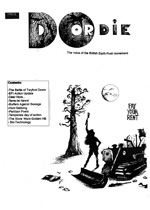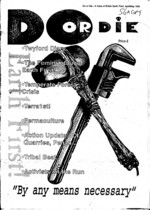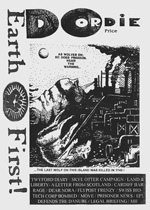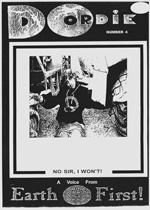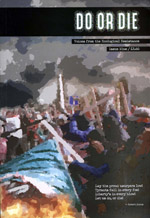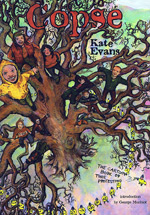The Archives
-
Do or Die, Most Popular, Periodicals
Do or Die – The Complete Set!
04.09.14 | PermalinkDo Or Die #1-10 (1993-2003, Brighton, England.)
A few years ago a friend asked me if I had a complete set of Do or Die, the British Earth First! publication that inspired and incited eco-warriors throughout the 1990s and early 2000s. At one time I did have them, but they had long since been stolen by a Joint Terrorism Task Force.
After a brief discussion, we decided that Do or Die was too important to fade into obscurity. We began tracking down each issue, and decided that while we were at it we ought to archive some other publications as well. That effort is how this web site began, and now, thanks to 56a infoshop of South London and Tim @ NEDS Northampton, we can finally share the very rare issue #2. This completes our collection, and our original mission as well.
When read as a set, Do or Die is a chronicle of people from across the globe counter-striking capitalism, ecocide, and the state. Each issue is better than the last, but more importantly, each page is a spark licking at the fuse of the bomb that is your heart. Once lit, you’ll know that these pages are not mere history, but a reminder that we can explode onto the world stage like the fighters before us have. Do or die, now is the time to rise.
…
-
Do or Die, Most Popular, Periodicals
Do or Die #10
06.10.13 | PermalinkDo Or Die #10 (2003, Brighton, England.)
It’s hard to believe that it has been a decade since the Do or Die collective published the final issue of their influential, book sized periodical. This last dispatch screamed the same urgent message as its predecessors: Take action now, or die alongside the rest of humanity in the coming ecological meltdown.
In the ten years since our situation has only become more desperate, and therefore the inciting cries for resistance in the pages of Do or Die have only increased in relevance. Plenty has been written on this site about this publication: that it was our reason for starting TALON, that it was the best environmental publication ever, and so on. None of that will matter if DoD’s message is ignored. Read these pages with an eye towards how you will utilize the lessons contained inside. Then, start making plans to create a better world, and implement those plans quickly, because as the title suggests, if you don’t “Do” than our species has only one other option…
The other issues of Do or Die in our archive can be found HERE.
…
-
Do or Die, Periodicals
Do Or Die #1,3,4
06.18.12 | PermalinkDo Or Die #1,3,4. (1993-1994, Brighton, England.)
When a group of five environmentalists gave birth to Earth First! in 1979 they could have hardly imagined how far the movement would spread and how influential its politics would become. From humble roots in the Southwest, chapters began proliferating across the United States and soon left its borders as the worldwide eco-catastrophe inspired people everywhere to take action. In 1992 the first British Earth First! chapter was founded, and within a year one of the most exciting periods of mass direct action in modern history was well underway.
From the start the movement in the UK seemed a little smarter than their US counterparts, perhaps because they had learned from the worst offenses of the fledgling stateside groups. Eschewing the more anti-social elements of American deep ecologists, our comrades across the pond sought to build a broader base and included those working in other movements. They also seemed to have a creative flare for mischief, and their best actions not only stopped the despoilers- they also put a smile on the face of rebels everywhere.
The spectacular campaigns of the UK EF!ers were covered in Do or Die!, a wonderfully self-critical journal that started as a small newsletter and blossomed into a massive annual tome by the end of its existence. Find the other issues HERE.
…
-
Do or Die, Periodicals
Do or Die #7
01.30.12 | PermalinkDo or Die #7 (1998, Brighton, England.)
The genesis of Conflict Gypsy came from our founder’s desire to collect and preserve a complete set of Do or Die, the classic British Earth First! publication. While we still have not found copies of issues 1-4, our posting of these book sized epics continues with issue #7.
Do or Die was always reasonably free of the acritical cheer leading of it’s many American counterparts, and this issue manages an honest examination of the limitations and capabilities of direct action campaigns from Poland to Brazil to Mexico. As always, there is a bittersweet mixture of inspiration and despair while reading about the clashes between the oppressed and the powers of the state and industry, but there are enough victories contained in this volume that elation prevails! You will cheer as the black bloc escapes arrests in Derbyshire by switching into hippie clothing and shouting “no violence” as the police roll in (An activist in England nearly pissed themselves telling me that story one night!) and as wild boars recruit domesticated pigs for non-human resistance to domestication. The power of villagers in India to stop dams lessens the pain of reading about the paramilitary massacres of people in Acteal, and other articles will have you thinking deeply about our movements DIY media efforts, prison support, and coalitions with labor groups. All in all, another must read from one of the most exciting periods of resistance in the 20th century.
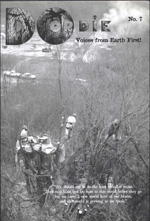
-
Books, Most Popular
The Black Cat Sabotage Handbook
10.31.11 | PermalinkThe Black Cat Sabotage Handbook, 3rd edition (1996, Eugene, OR.)
When I was a kid the world didn’t have the sort of instant gratification now expected for all transactions, and thank goodness. You can really appreciate the value of something more once you’ve clipped five proof of purchases, put them into an envelope, mailed them away, and waited 6 to 8 weeks for your Zartan action figure to arrive. Distribution for the Black Cat Sabotage book worked the same way – you clipped an ad out of a zine and mailed it in along with concealed cash. A few months later a copy showed up in a nondescript envelope. I still remember when mine was delivered…
My first copy of Black Cat left me feeling like I was involved in some sort of conspiracy just turning the pages. Sure, most of it was reprints that I had already seen before, but the layout, the graphics, and the text all seemed to carry the message that action was urgent and that the enemy was watching. (Of course, we were all sending envelopes with our return addresses to the same damn PO Box in Eugene, so if anyone was watching they already knew who we were!) At the time I didn’t know who was publishing or distributing it, but rumors eventually surfaced in the mid 2000’s that the book was compiled by Bill Rogers, an accused Earth Liberation Front member who took his own life behind bars in 2005. In his suicide note he said that his death was a “Jail break,” and as he slowly suffocated himself with a plastic bag he gripped one hand into a fist, and with the other, extended his middle finger.
I only met Bill one or two times and did not get to know him well, but since his death I have heard many complicated things about him. From what I gather he was at times heroic, but had some serious, perhaps unforgivable flaws that should not be ignored. In that respect he is like the book that he was rumored to have clipped together and sent out anonymously. The Black Cat Sabotage Handbook contains some good bits of information, some serious inspiration, and some decent arguments for the use of sabotage and even violence. Likewise, it also contains some foolhardy nonsense that could get someone jailed or killed for little positive gain. The cover shouts, “BEWARE!” and smart readers will heed that advice.
In closing, here is to Bill. He was a man I can best respect by keeping off a pedestal. I can not deny that many of the stories about him are disconcerting, but I also can not deny the beauty of his attempts to spark a revolution against industrialism. As his friends sat shivering and complaining in a car, it was Bill who trekked alone through snow, uphill and burdened with the weight of gallons of fuel to set a fire that would announce to millions the existence of the Earth Liberation Front. That speaks volumes about his fighting spirit, and his wild drive to right the wrongs our species has perpetrated. His death saddens me, but something tells me that someone so intent on freeing others would not have done well spending decades behind bars- perhaps in that sense his “jail break” really was a form of escape. He will be remembered as a warrior.
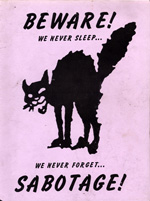
…
-
Do or Die, Periodicals
Do Or Die #6
09.19.11 | PermalinkDo Or Die #6 (1997, Brighton, England.)
“There have been many rational arguments about the usefulness of this action to the campaign, but to anyone who watched the route being transformed from beautiful countryside to churned mud and charred stumps, there is at least a sense of natural justice to the sight of the last tree on route silhouetted by the flames of burning machinery.” -Anon. From the article “Newbury, an adrenaline junkies idea of heaven.”
By the time 1997 rolled around Britons could not help but be aware that something major was afoot in their country. Dock workers were uniting with anti-car anarchists, squatters were preventing the demolition of entire communities by occupying building slated to be torn down, there seemed to be a punk or a hippie in every tree in the whole damned country, and when police got in the way they faced riots as a result. Amidst this flurry of activity though, those on the inside knew that their movement was in terrible danger from forces both internal and external. With time short and resources low they began to discuss how to prevent catastrophe. In the end they failed, but they left behind a wonderful warning of what happens when we analyze our tactics, morale, and outreach too late.
This is not to say that Do Or Die #6 is a doom and gloom journal of a dying movement. Much to the contrary, this issue foresaw the collapse but was written when activity was still peaking. Amongst the analysis of their campaigns and politics, Earth First in the UK and Europe as a whole found plenty of time to get down to the joyous work of resisting industry and capital. There is no way that one can not read some of the stories inside without feeling a boost of adrenaline. From the theft of bulldozers to destroy a construction site to the rampaging of drunken elephants against military bases, to the building of a free state on american soil, all variety of species get down to the usual business of ruining business as usual. Inspiration abounds!

…
-
Do or Die, Periodicals
Do or Die #5
07.02.11 | PermalinkDo Or Die #5 (1995, Brighton, England)
The story of Earth First! in the United States is well documented and frequently repeated, and someday it will certainly make it’s way to digital distribution here on Conflict Gypsy. (Scanning those hundreds of copies of EF! Journal is going to put our volunteers into early graves if we are not careful, so don’t expect to see a full set anytime soon!) Until that time it is our pleasure to delve into the history of Earth First! elsewhere in the world, starting in England and the other places still under colonial rule known as the “United Kingdom.”
Beginning in 1991 there was an explosion in activism across the pond. Wilderness, urban environmental, anti-road, alternative transportation, animal liberation, anarchist, squatters rights, and other specialized, single issue activist realms began to coalesce into an exciting new mass. The origins of this widespread movement had broad roots. Some trace its beginnings to the poll tax riots, others say it was government crack downs on raves, squats, and social centers. Where ever it came from, it grew within a few short years into a spectacular and inspiring mess for the status quo!
From encampments protecting wild areas, to sabotage, to street protests that took over whole city centers, the UK suddenly seemed alive with resistance. While never reaching a size that threatened the powers that be, these outbursts of love and aggression were never the less refreshing to those of us in the United States longing for a similar explosion in revolutionary zeal. Suddenly, Do Or Die became the must read publication that no-one could quite seem to get their hands on!
Professionally bound and book sized, each issue of DoD contained news, research and analysis about the exploits of radical activists worldwide. Conflict Gypsy will be posting a full set of these journal format prizes as they become available to us. The earliest issue in our collection, #5, contains lengthy articles on the live export protests that eventually ended with the death of Jill Phipps, the NO M65 campaign, and virtually everything else worth noticing in Europe in 1995. If you have earlier editions of DoD, please contact us at conflictgypsy (at) gmail (dot) com

…
-
Books, Most Popular
Copse
05.29.11 | PermalinkCopse (1998, Kate Evans, Chippenham, England.)
“The direct action campaign against road building in Britain is the most successful revolutionary movement in Western Europe in the Second half of the 20th Century. Never before in this period have such radical aims been so comprehensively achieved in so short a time. Never before has a central component of government policy, to which billions of pounds had already been committed reversed, without the need of a change of government, by citizen politics. The humble, impoverished people who fought and won this war have plenty to be proud of.” -George Monbiot, from the introduction.
Sometimes a social ill can become so prevalent that it is sewn into the fabric of our society, normal in all senses, and so common that invisibility is reached. So it is with the car. Whether fueled by gasoline or electricity, bio-diesel or hydrogen, the automobile is one of the most destructive things on earth. Cars emit more than half the world’s air pollution, and kill more animals every year than the fur and vivisection industries combined. But that is only the beginning of the problem. You see, cars require roads, and they travel on them at deadly speeds. What this means is that the streets– a commons where people once gathered– are no longer a place to live and interact, but a place to pass through. The automobile has completely altered our social structure and harmed the ability of normal people to meet and share their discontent with the existing order. Roads now take up more than 1/3rd of most cities, and when parking, garages, gas stations, and other things necessary to feed and house cars are taken into consideration, more than half of our urban space is dedicated to traveling metal boxes. This is an ecological and social catastrophe that goes largely ignored even amongst those who care about human community, wilderness, and non-human animals.
But, it wasn’t always this way. Less than 20 years ago thousands of people fought against the building of new roads in England and elsewhere, and the actions which they undertook are greatly inspiring. From complex villages of tree sits and blockading devices to mass daylight arsons, the anti-roads movement was tremendously successful in preventing the furtherance of car culture and its corollary social and environmental impact.
There were many attempts at documenting this exciting people’s struggle, but none of them were quite as fun as Kate Evans’ Copse. Comprised of interviews, photographs, essays, and plenty of comics, Copse distilled the spirit of the protests onto each page. Part history lesson, part graphic novel, this book is a great starting place to understanding an important piece of the recent history of mass direct action.
…
